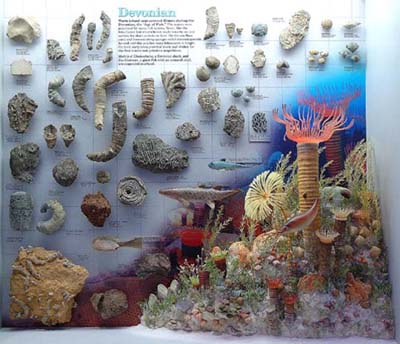
Illinois State Museum Exhibit
417–354 Million Years Ago
Devonian Period
During the Devonian, a shallow sea covered Illinois and much of North America. To the east, the Appalachian Mountains were being forced up as the North America collided with Africa. Mountains were forming in Arkansas and southern Missouri. Erosion from them covered the sea bottom in southern Illinois with silt and mud.
Warm inland seas covered Illinois during the Devonian, the "Age of Fish." On the sea floor, coral and lime-secreting sponges called stromatoporoids formed large reef-like patches.
Weather events can leave a record in the rocks. Tropical storms would periodically flatten and bury these underwater environments. Organisms colonizing the new, surface started the cycle over again. This rhythmic change in the environment and species is recorded in the distinct bedding planes (layers) of the rocks.
A Lower Devonian Bioherm,
380 Million Years Ago
Corals and other organisms growing on the sea floor sometimes formed dense
patches called biostromes. The living upper surfaces of the organisms rose
above the sea floor. As sediment accumulated, they grew to keep pace forming
broad, reef-like mounds called
bioherms. They are seen today in the Grand Tower Limestone and in Indiana, Ohio, and New York.
This reconstruction is based on
fossils from the Grand Tower Limestone of Union County, Illinois.